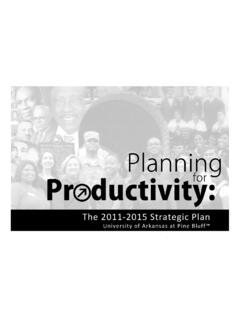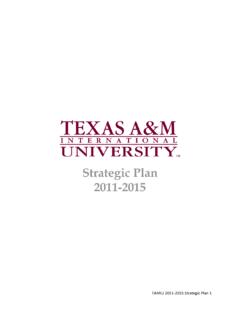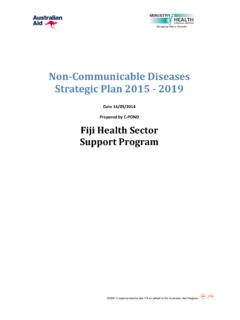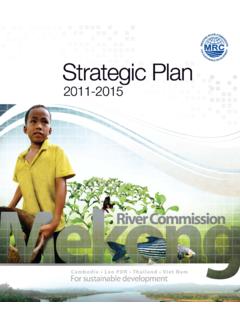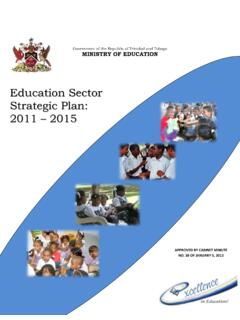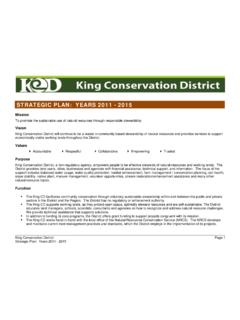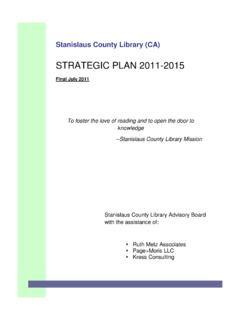Transcription of National Council Strategic Plan 2011-2015 - Boy Scouts of ...
1 National CouncilStrategic Plan2011- 2015 Impact & ParticipationResources & FinancesBuilding Our BrandDynamic & Relevant Innovation & TechnologyAdvocacy & RelationshipsLeadership & CultureBSA : APPS forOur Second CenturyiIntroductionAs our first century of Scouting comes to a close, I am delighted to share with you our 2011 2015 National Council Strategic plan . This document represents the confluence of our vital mission with a clear corporate direction and will be the cornerstone for our second century of Scouting. I am particularly proud of the grassroots support and feedback given by Scouters throughout the country that provided guidance as we developed objectives and goals that are in direct support of local councils. This investment made in setting our course may well be one of the most significant accomplishments in the history of our National Council is committed to following this Strategic direction with a very formal process; allocating manpower and financial resources appropriately, and setting course cor-rections as the environment dictates.
2 The stakes are simply too high to put forth anything but our best effort. I offer my personal thanks to Steve Weekes, the Strategic Planning Steering Committee, and the hundreds of volunteers and BSA employees whose extraordinary passion and talent have led us to the doorstep of our second J. MazzucaChief Scout ExecutiveOnce again, I am reminded of the challenges and rewards that come with active participation in Scouting. The development of the 2011 2015 National Council Strategic plan has proven to be an interesting and satisfying experience for me, and I am extremely grateful for the efforts everyone has made to contribute to our exciting new the past 15 months, our 39-member Strategic Planning Steering Committee met four times, and the pillar subcommittees participated in many additional meetings and conference calls. Throughout this process, we formally engaged our local councils and National Executive Board members four times, seeking their input and advice.
3 The feedback from more than 1,500 of our members proved to be invaluable, and after numerous drafts, our steering committee completed a plan outlining seven pillars, 26 objectives, and 104 specific goals which are to be accomplished over the next five is important that all of us understand that the goals in this plan are for the National Council . Included are goals that will provide direct support to local councils and goals that will help create an environment across the country that is conducive to the success of Scouting. To help local Council Strategic plans link to the National Council plan , an interactive, online Strategic planning tool titled My Council plan has been developed. By using this tool, including its business report card, SWOT analysis, and focus area self-assessments, local councils can work to align their Strategic plans with the seven pillars and respective vision statements. We have a bright, exciting future in Scouting, and this new plan will guide us to higher levels of service to our nation as we begin our second E.
4 WeekesChairmanStrategic Planning Steering CommitteeSteve Weekes, Committee Chairman John Gottschalk Tico Perez Jack Furst Wayne Perry Keith Clark Nathan Rosenberg Steve Hanks Bob Reynolds Mike Daniel George Francis Ed Lewis Ron Yocum Margaret Lifferth Robert Mazzuca Willie Iles Al Kugler Wayne Brock Jim Terry Fred Meijering Stephen Medlicott John Green Gary Butler Michael Ashline Tom Fitzgibbon Brad Farmer Alf Tuggle Sharon MouldsJim Gilbert Strategic Planning Steering CommitteeNational Executive Board and Advisory Council MembersNational Council StaffScout ExecutivesPaul Moore Tom Varnell Mike Surbaugh Mark Logemann Scott Beckett FacilitatorStrategic planning facilitation was provided by Insigniam of the Boy Scouts of AmericaIt is the mission of the Boy Scouts of America to prepare young
5 People to make ethical and moral choices over their lifetimes by instilling in them the values of the Scout Oath and Scout Scout OathOn my honor, I will do my best to do my duty to God and my Country and to obey the Scout Law; to help other people at all times; to keep myself physically strong, mentally awake, and morally Scout LawA Scout is trustworthy, loyal, helpful, friendly, courteous, kind, obedient, cheerful, thrifty, brave, clean, and Future StatementIn Scouting s second century, we are building the leaders of tomorrow. Scouting s dynamic and engaging journey beckons to America s young people. Our exciting programs and outdoor adventures inspire lives of leadership, character, and service. Relevant and adaptive, we are a trusted advocate for youth. Our adult volunteers and employees are widely admired for their leadership excellence. The Boy Scouts of America is strong and financially secure. True to our mission, Scouting reflects our nation in its ethnic diversity, and shapes our nation by developing responsible citizens.
6 National CouncilStrategic Plan2011-20152011 2015 Strategic Pillars 1 Impact & Participation 2 Resources & Finances 6 Building Our Brand 8 Dynamic & Relevant Program 10 Innovation & Technology 12 Youth Advocacy & Strategic Relationships 14 Leadership Excellence & Culture 18 Table of ConTenTs1 IMPACT & PARTICIPATION: Scouting s programs reach and make a life-changing difference with kids of all backgrounds and & FINANCES: The Boy Scouts of America is financially sound at all levels of the organization through a balanced funding model. Funding is not a barrier to providing programs that fulfill our OUR BRAND: The Boy Scouts of America is known and valued by the people of our nation. Our brand is so recognized and respected that it empowers our members and enables our & RELEVANT PROGRAM: Scouting s programs are exciting, culturally relevant, and appealing to today s youth; attracting them at an extraordinary rate and retaining them & TECHNOLOGY: Scouting uses innovation and technology to support the Strategic pillars and to increase the impact and potency of the Scouting movement.
7 All members of Scouting are connected with the right information and technology tools anywhere, anytime, to any ADVOCACY & Strategic RELATIONSHIPS: The Boy Scouts of America is recognized as an advocate for youth and youth issues. We are known by our members and America s families and communities as a resource for leadership, encouragement, and programs that benefit our country s youth. The Strategic relationships of the BSA extend far beyond those with our traditional chartered organizations and keep Scouting relevant and adaptive. LEADERSHIP EXCELLENCE & CULTURE: Scouting s youth, volunteer leaders, and employees exemplify leadership excellence across all aspects of the movement. 2011 2015 Strategic PillarS2 Our VisionScouting s programs reach and make a life-changing difference with kids of all backgrounds and Council Strategic Objectives & GoalsObjective I: The BSA measures its success by the increase in the positive, difference-making impact it has in the lives of to Achieve the Objective: Develop new metrics for measuring the outcomes of Scouting in youth, families, and communities.
8 Articulate our new focus on Scouting outcomes to our membership, employees, and the public. Revise recognition and reward programs to reflect our new focus on Scouting Goals: 1. We have developed a new definition of success, including a set of clear, measurable outcomes for the Scouting program, and have implemented new metrics for assessing the performance of BSA employees and volunteers. [May 2012] 2. In coordination with our councils, we have newly defined success for units, districts, and councils using a balanced scorecard approach that measures mission impact, customer satisfaction, and financial sustainability. [December 2013] 3. We have developed and introduced a communication structure for both gathering and disseminating to our membership insightful and useful feedback and information from our chartered organizations and key community institutions ( , schools and churches) about how and where Scouting can best support the needs of the youth and communities it serves.
9 [December 2012]imPact & ParticiPation 3 Objective II: The BSA has increased its market share at all levels (unit, district, Council , and National ) through a robust and comprehensive approach to diversity and inclusion of minorities, women, and other underserved to Achieve the Objective: Incorporate ethnic diversification of our membership into the BSA definition of success. Ensure that the National Executive Board and local Council executive boards reflect the ethnic diversity of the geographical areas they serve. Clearly identify our ethnic market share in all communities and seek to increase that market Goals: 1. We have implemented a tracking system for more effectively measuring ethnic and other desired demographics of BSA youth membership, and have established appropriate benchmarks for minimum and desired performance at the local, Council , and National levels. [December 2011 ] 2. We have recruited ethnically diverse, qualified, and committed individuals in proportion to our demo-graphics onto the National Executive Board and regional boards, thereby providing a model for local councils.
10 This effort provides better representation of our intended BSA membership. [May 2012] 3. In partnership with our councils, we have developed and implemented strategies, including market seg-mentation, to increase market share in councils with high minority representation, specifically focusing on African American, Asian, and Hispanic youth and adults. After establishing a baseline by developing demo-graphic tracking capability in ScoutNet, we have achieved four years of increasing market share in each of these target minority groups, beginning in 2012. [December 2012] 4. We have altered BSA professional employee personnel evaluations, development, and recognitions to include ethnic membership diversification as a key metric for each Council . [December 2012]Objective III: The BSA has increased its net membership by retaining youth in the Scouting program to Achieve the Objective: Determine the drivers of retention. Streamline the registration and transition process to facilitate long-term participation.


